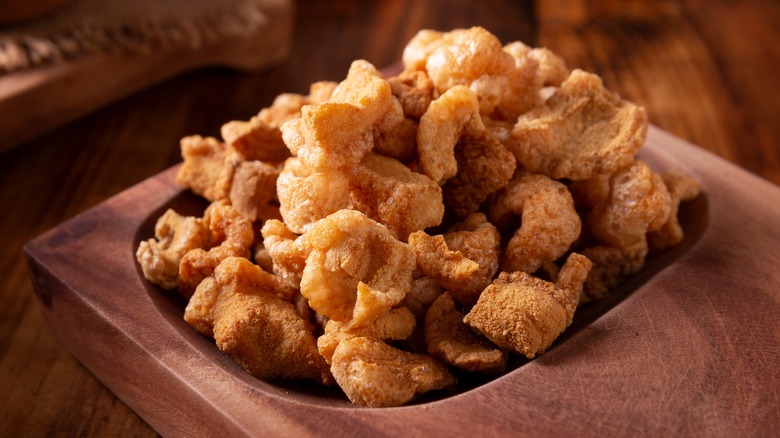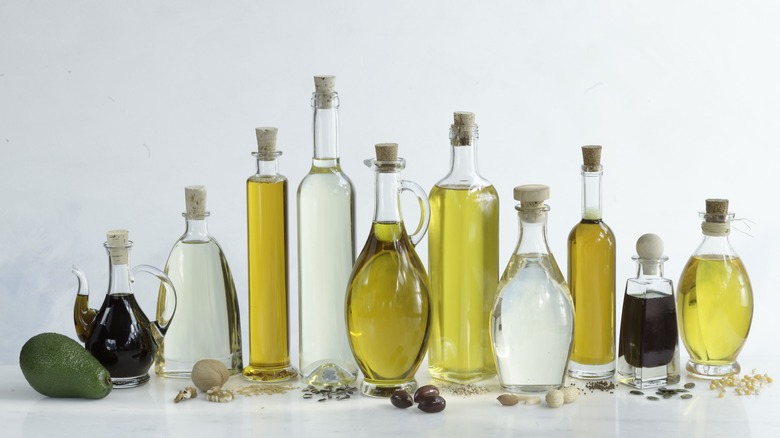What's The Best Oil To Use To Fry Up Homemade Pork Rinds?
Crispy and delicious, pork rinds are a Southern delicacy that takes pig skin and turns it into a deliciously savory snack with a distinctively airy but crunchy texture. The process of making pork rinds at home isn't too terribly complicated if you have the right setup for frying things in oil — however, as with any other kind of fried food, picking the right kind of frying oil is one of the most essential parts of the process. While the matter of which oil imparts the best taste or texture to pork rinds is a matter of personal preference, there is one rule of thumb to adhere to no matter what: The oil must have a high smoke point that can withstand the temperatures needed for frying food.
When oil exceeds its smoke point, it undergoes a process known as "breaking down" or "oxidation," leading to various changes in its chemical composition and physical properties. The smoke point is the temperature at which an oil starts to produce visible smoke, and exceeding this temperature can have several negative consequences such as the release of harmful compounds, changes in flavor and aroma, nutrient degradation, the formation of acrolein, and more. Not only will your pork rinds taste worse, they might also become bad for your health due to the toxic compounds generated by the broken-down oil.
Breaking down your options
Generally speaking, you'll find that the frying temperature of pork rind recipes will vary somewhere between 325 to 375 degrees Fahrenheit. Subsequently, you'll want to pick cooking oils with a smoke point higher than that range of temperatures, preferably ones with a more neutral taste that doesn't impart any distinctive flavor notes when frying the pork rinds. Some of the best candidates include safflower oil, refined peanut oil, and refined sunflower oil, which all have high smoke points ranging from 450 degrees Fahrenheit and above, as well as mild flavors that won't overpower the pork rinds. Other good options are canola oil and vegetable oil, which have a range of smoke points around 400 degrees Fahrenheit and up; slightly lower than safflower oil but still well above the usual frying temperature for pork rinds.
However, an important thing to keep in mind when considering any frying oil is the potential health issues arising from allergies or other medical conditions. While studies have shown that refined peanut oils are safe for anyone with a peanut allergy, many individuals can have allergic reactions to safflower oil. Allergic reactions to refined sunflower oil are rare, but not unheard of. On top of it all, some oils like canola oil are known to cause IBS flare-ups due to their chemical composition. All in all, it's important to keep health considerations in mind when choosing a frying oil for any kind of fried food.
Other things to consider
It's worth noting that the cooking oil with the highest smoke point is refined avocado oil, with a smoke point range of 480-520 degrees Fahrenheit. Scientifically, it's the safest frying oil for any kind of fried food, but the unfortunate reality is that it's hard to get your hands on a good bottle of pure avocado oil. Unless you're buying from Costco, studies have shown that store-bought avocado oils have a bad tendency of being diluted with other oils — meaning that its overall smoke point will be lower than expected.
On the other end of the spectrum in terms of smoke points and affordability, one unexpected contender for good oils to fry pork rinds in is lard. With a smoke point of 370 degrees Fahrenheit, you wouldn't think that it would be a popular choice for frying — however, it was the go-to oil for frying before the advent of commercially produced, vegetable-based oils, and it remains a popular frying oil for many people across the world. Imparting a more traditional savory flavor to pork rinds, lard and/or rendered animal fats just might be the rustic touch you're craving in a fried snack. If you use a thermometer to keep your frying temperature steady at 350-360 degrees Fahrenheit, lard is a perfectly safe — and tasty — option for homemade pork rinds.


